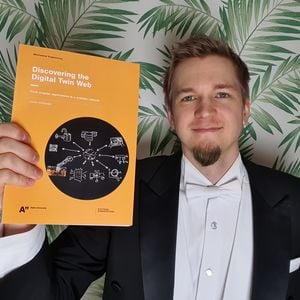Dissertation in the field of mechanical engineering, Juuso Autiosalo, M.Sc. (Tech.)

When
Where
Event language(s)
Remote participation via Zoom: https://juu.so/public-examination
Title of thesis: Discovering the Digital Twin Web - From singular applications to a scalable network.
Opponent: Adjunct Professor, Research Director Jari Kaivo-Oja, University of Turku, Finland Futures Research Centre
Supervisor: Professor Kari Tammi, Aalto University, School of Engineering, Department of Mechanical Engineering
Contact information of doctoral candidate: Juuso Autiosalo, [email protected]
Electronic dissertation: http://urn.fi/URN:ISBN:978-952-64-0621-3
Contents of dissertation release:
Initiative suggests building a global network of digital twins
Digital twins are virtual counterparts for real-world entities. They contain one or more
features, such as simulation models, data storage, and artificial intelligence, that
enhance the life of the real entity. Until recently, digital twins have been developed as
one-off applications that serve only their specific use case.
This dissertation introduces the Digital Twin Web initiative for creating a global network
of digital twins. The Digital Twin Web, a.k.a. Twinweb, aims to become as prevalent as
the World Wide Web (WWW), unlocking the network benefits of user-friendly and
globally standardized twins. The basic principles and structure of Twinweb are
described in the dissertation, mimicking many of the conventions of WWW, such as
open standards, developer-friendliness, and client-server architecture. The Twinweb
initiative aims to find the HTML equivalent for digital twins. If successful, Twinweb can
help fulfill the promises of Industry 4.0, the Internet of Things, and artificial intelligence.
The Twinweb approach is based on the results of four journal articles that present a
feature-based digital twin framework, a case study on industrial digital twin
development, experimentation on a digital twin document, and server software for
distributing digital twin documents. First, the framework presents a general, scalable
approach for creating digital twins, suggesting a “data link” feature to combine building
blocks into one twin. Second, the case study reports lessons learned from building a
data-focused, multi-component digital twin for an overhead crane in collaboration with
industry partners. The third article built a proof-of-concept for the data link feature,
introducing a digital twin document as part of the solution. Fourth, the open-source
server software “Twinbase” distributes digital twin documents from owners to users.
Digital twin documents must be standardized before the global network of digital twins
can be built. There are already a couple of competing specifications, and combining
them into one approach seems possible and fruitful. The future of networked digital
twins seems bright.